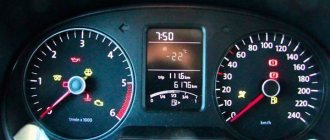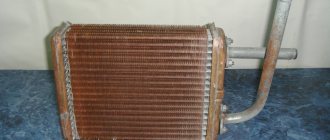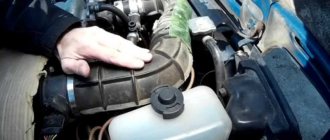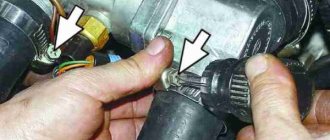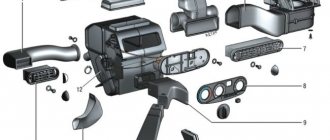A hot top and cold bottom of a car radiator is a normal condition only for cold engine after launch. If the engine has been running for several minutes, during which the coolant temperature has already reached 80–90 degrees (depending on the model), and the upper radiator pipe is hot and the lower one is cold, this is sign of trouble in the cooling system. However, there are exceptions to this rule.
The main reasons why the lower radiator hose is cold after warming up are a malfunction of the thermostat or pump , or a clogged radiator . This article will tell you how to determine the specific cause of the problem and what to do in this case.
What can cause the lower radiator hose to be cold and the upper hose to be hot?
Coolant circulation diagram: Click to enlarge.
Whether the lower radiator hose should be cold depends on the path of antifreeze.
After starting the engine, it first circulates in a small circle, bypassing the radiator, and after reaching a temperature of about 85 ° C , at which the thermostat partially opens, it goes to a large one.
In most models, coolant enters the radiator through the upper pipe, after which it is pumped down and returns through the lower pipe to the engine cooling jacket.
In those models where the thermostat blocks the flow of antifreeze from the radiator (for example, VAZ 2109), the lower pipe may be cold while the upper pipe is hot and before the engine warms up. If both channels or the radiator inlet are blocked (as on the Lada Granta), when the upper pipe warms up, both the radiator and the lower outlet should quickly warm up.
With a working cooling system, the bottom of the car radiator is cold and the top is hot only at the moment when the thermostat has already opened slightly, but the antifreeze has not yet reached the lower pipe. When the air temperature is low and the interior heater is on in winter, it takes longer for the coolant to warm up. In this case, the thermostat opens 10 minutes or more after the start of movement. At low air temperatures, it often happens that a car’s radiator is hot on top and warm on the bottom, since antifreeze quickly cools down as it passes through it.
Diesel engines warm up much slower than gasoline engines. Some cars with a diesel engine in winter can only fully use the large circle when driving at high speed (over 100 km/h) and during long periods of “taffy” in traffic jams.
You need to figure out why the lower radiator hose is not heating up and solve the problem in the following situations:
- the upper pipe is hot, and the lower one remains cold even after high-speed driving in warm weather;
- the radiator warms up only at the top, remaining cold at the bottom;
- coolant temperature readings on the dashboard go into the “red zone” ( more than 100–110 degrees );
- Antifreeze is boiling in the expansion tank.
The main reasons why the upper radiator pipe heats up and the lower one is cold:
Why does an air lock appear in the cooling system: video
- Thermostat is stuck in the closed or half-closed position.
- cooling pump is worn out and cannot create the required pressure.
- radiator channels with deposits.
- An air lock has formed in the cooling system.
Cooling system malfunctions are not always reflected in sensor readings. The coolant temperature sensor (coolant temperature sensor) may not be in contact with the overheated liquid and show a normal temperature. For the same reason, the radiator fan may not turn on in a timely manner.
Computer diagnostics only help identify problems with an electronically controlled thermostat. A problem with a mechanical valve is indirectly indicated by the non-corresponding readings of the DTOZ located on the block, in the cylinder head or in the area of the thermostat.
You cannot operate the car if the car is heating up and the lower radiator pipe is cold! This is fraught with a breakthrough of the gasket between the head and the block, failure and damage to the cooling system pipes, misalignment of the cylinder head, scuffing and wedge of the engine CPG due to overheating!
VAZ 2106 is heating up: causes and consequences
Usually the VAZ 2106 heats up in the summer heat, but this can happen in the spring and autumn, and even in the frosty winter! In addition, in this situation there is a threat of failure of important components of the vehicle. A possible cause may be wear on the oil seals or rings on the piston. They, as a rule, lie down and stop performing their direct duties.
From high temperatures they become unusable, and increased combustion of oil begins. Also, when the engine overheats, the cylinder block becomes deformed. This is already a serious problem, since urgent repairs will require a considerable amount of money, which will certainly affect the family budget. It is not difficult to determine if a car engine is overheating. There is a sensor on the instrument panel for this purpose. The arrow will show a temperature of more than 100 degrees.
The sound of boiling liquid may be heard from under the hood of the car. Sometimes there is even steam. In this case, you urgently need to stop the vehicle and turn off the engine. Slowly open the hood, followed by a barrel of antifreeze so that the hot steam comes out. It is better to immediately turn on the fan to cool the overheated radiator.
How to determine the reason why the lower radiator hose is cold and the upper one is hot
The lower radiator hose is slightly cooler than the upper one, since the antifreeze coming from above cools down as it passes through the radiator. But, as a rule, we are talking about a relatively small temperature difference. When the outlet pipe/hose from the radiator does not warm up at all, this indicates a violation of the coolant circulation and heat exchange in the internal combustion engine.
All common reasons why a cold lower radiator pipe does not heat up normally are collected in the table.
| Possible reason | Consequence | How to understand/define it |
| The thermostat is stuck in the closed or half-closed position. | The coolant circulates in a small circle and does not cool. |
|
| The expansion tank cap valve is faulty. | The pressure in the circuit is not automatically regulated, which may cause air pockets. |
|
| The radiator channels (lines) are clogged. | Antifreeze does not pass through the radiator and circulates mainly in a small circle. |
|
| The water pump impeller is worn out. | The pump cannot create the required pressure, which causes the coolant circulation and heat transfer from the engine to the radiator to deteriorate. |
|
| There is an air lock in the cooling circuit. | Coolant circulation deteriorates, heat exchange is disrupted, and pipes may swell and rupture. |
|
Cabin filter and air duct clogged
rightwayautorepair.com
Sometimes the cause of a poorly functioning heater can be a dirty cabin filter or leaves, insects and dust getting into the air duct due to its absence. In this case, the radiator itself warms up, but cannot release heat due to the weak air flow.
What to do
Check the cabin filter and replace it if necessary. If there is no filter at all, although there should be one, then clean the air duct of debris. If possible, get to the heater core itself and blow it thoroughly with compressed air.
Cars that most often have heat transfer problems
On some cars, the situation where the upper radiator hose is hot and the lower hose is cold is more common than others. Such models and their “childhood diseases” are collected in the table below.
| Brand, model | Cause of the problem | How can I fix it? |
| VAZ 2106, 2101 and other “Classics” | Low quality of original components, in particular the thermostats themselves, which jam. | Instead of the original VAZ thermostat valve, use parts from other companies: Metal Incar, Finwhale, Vernet. |
| The cold bottom of the radiator in a VAZ “Classic” with high mileage is a consequence of corrosion of parts and clogging of the radiator channels. | Flush the radiator using a special fluid or, if that doesn’t help, replace it. | |
| VAZ 2108-21099, 2113-2115, Kalina | A faulty expansion tank cap valve does not allow maintaining operating pressure in the cooling system, which disrupts coolant circulation and causes the heater to heat poorly. | Replace the expansion tank cap. |
| VAZ 2110 – 2112, Lada Priora | On the VAZ 2110-2112, the lower pipe is cold, and the heater blows cold due to the predisposition to the formation of traffic jams and disruption of coolant circulation. | Monitor the condition of the cooling circuit, remove plugs, especially when replacing antifreeze. As a radical solution, you can replace the thermostat with a “six-hole” one (art. 21082-1306010) or from Lada Granta (21900-1306010), adapting the circuit to it. |
| The upper pipe is heated, and the lower pipe is cold, due to exhaustion and lack of pump performance. | Install an improved pump, like the Luzar Turbo. | |
| Skoda Octavia | On the Skoda Octavia, the lower radiator pipe is cold, and the engine begins to overheat due to a faulty oil heat exchanger gasket. | Replace the oil heat exchanger gasket. |
| Daewoo lanos, Sens, ZAZ Chance | Cold lower pipe and radiator, a consequence of early opening or jamming of the thermostat. | Replace the thermostat with a better one that opens at 87 degrees. |
| Ford Focus | On a Ford Focus, the bottom of the radiator is cold and the top is hot, usually due to a stuck thermostat. | Replace the faulty thermostat. |
| Mazda 3 | On a Mazda 3, the lower pipe is cold, usually due to a faulty thermostat. | |
| Volkswagen Passat | With high mileage, the pump and thermostat fail. | Replace the pump or thermostat. |
| Suzuki Grand Vitara | Airing of the cooling system due to pressure failure. | Remove air pockets. Replace the expansion tank cap, which often becomes clogged or, on the contrary, does not hold pressure. |
Checking the Thermostat
If you are still not sure that the thermostat is indeed stuck in one position, then follow the following procedure to definitively determine the cause of the engine overheating or taking a long time to warm up. That is:
1. Disconnect the negative terminal of the high voltage battery cable from the battery.
2. Drain some of the coolant from the system using the radiator cap or using the antifreeze drain hole provided in your vehicle. Drain approximately 4 to 5 quarts. That is, there is no such need to completely drain all the liquid from the cooling system. You need this in order to avoid the complete pouring of antifreeze from the system during the next effective step.
3. Remove the upper radiator hose.
4. Remove the thermostat housing.
5. Remove the thermostat.
6. Find the temperature marking on the thermostat housing at which it should begin to open. Remember this temperature.
7. Take a thermometer that can measure the temperature of boiling water.
8. Then take a saucepan and fill it with cold water. Place a thermometer in it and place it on the stove.
9. Next, place the thermostat in a pan of cold water and turn on the stove.
10. Now carefully monitor the temperature on the thermometer and the thermostat itself. If the thermostat is working properly, then when the water reaches the required temperature indicated on the thermostat body, it will begin to open. If this does not happen or the thermostat starts to come off when the water temperature reaches a higher temperature, then you will have to replace it with a new one, since this thermostat begins to open late at the wrong temperature or it is simply faulty.
If the thermostat opens when the water is heated to the temperature indicated on it, then it means it is fully operational.
Dirty radiator
The main reason for this, according to most experts, is a clogged radiator
. Over time, this important element of the cooling system becomes clogged with rust residue, dust, leaves and other debris. The location of the radiator is in front of the car. So, no matter what happens, it gets inside. Ultimately, all this leads to problems.
Since this reason is the most important, below is a method on how to clean a radiator. In addition, proper care of the radiator and its regular maintenance ensures the normal operation of the entire cooling system.
Once it has been decided to start by flushing the radiator, to eliminate the symptom described above, proceed in different ways:
- Or they go to the store and buy a new radiator;
- Or you can clean it yourself.
Coolant replacement
: Often, when replacing the coolant, beginners make a mistake and then complain about a cold pipe. This concerns a situation where the radiator itself is freed from old fluid, but the tank is forgotten. As a result, this affects the entire cooling system. It starts to act up and diagnostics give no clue.


